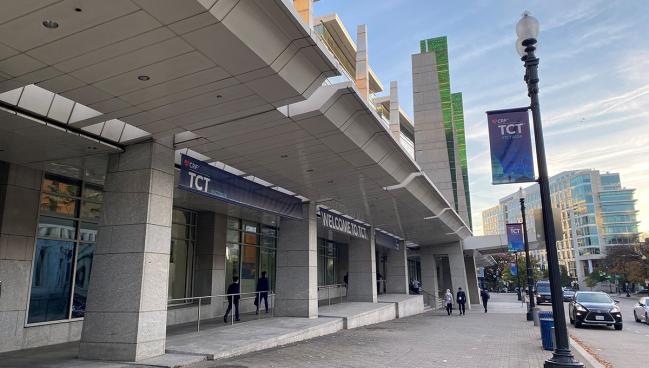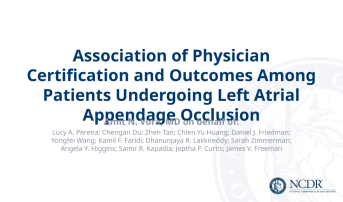LAAO Outcomes Similar Regardless of Operator’s Specialty
EPs in the US do more LAAO procedures than interventional cardiologists: a new analysis digs into whose outcomes are best.

WASHINGTON, DC—Procedural and clinical outcomes of percutaneous left atrial appendage occlusion (LAAO) are largely the same whether an electrophysiologist (EP) or interventional cardiologist (IC) is performing the procedure, registry data show.
Though EP-performed procedures were more likely to involve guidance by intracardiac echocardiography and came with lower radiation exposure and less contrast use, rates of death and major adverse events in the hospital and at 45 days did not differ based on what certification the primary operator had, Amit Vora, MD (Yale University School of Medicine, New Haven, CT), reported here at TCT 2024.
The findings, published simultaneously online in JACC: Cardiovascular Interventions, indicate that “continued utilization of this technology by both EPs and ICs is important to allow for broad access of the treatment, particularly in underserved areas,” he concluded.
LAAO is now an established alternative to long-term oral anticoagulation for patients with atrial fibrillation (AF) who have a reason to avoid it, and use has been growing rapidly. The procedure is performed by either electrophysiologists or interventional cardiologists, and their medical training largely overlaps, with the exception of the last year or two of procedure-specific training in fellowship. Whether LAAO outcomes differ between the two specialties hasn’t been clear.
To find out, Vora and his colleagues turned to the National Cardiovascular Data Registry LAAO Registry. The analysis included 91,711 patients (mean age about 76 years; 59% women) who underwent LAAO performed by 1,638 operators at 713 sites between 2020 and 2022. Occluder devices included the Watchman FLX (Boston Scientific) and Amplatzer Amulet (Abbott).
Using physician certification data from the American Board of Internal Medicine, the researchers determined that 61% of procedures were performed with an EP as the primary operator, with the other 39% led by ICs.
Compared with procedures led by EPs, the IC-led procedures were more likely to be performed at rural sites (12.2% vs 7.2%) and with baseline use of CT/CMR imaging (27.9% vs 24.9%; P < 0.001 for both). EPs were more likely to guide LAAO using intracardiac echo (25.2% vs 9.7%), with lower median values for cumulative radiation dose (air kerma 234 vs 308 mGy) and contrast volume (30 vs 35 cc; P < 0.001 for all). Procedures were slightly longer with EPs at the helm (median 74 vs 69 min; P < 0.001).
Procedure success rate was 98% irrespective of physician certification. EPs were more likely than ICs to prescribe a direct oral anticoagulant plus aspirin at discharge (48.0% vs 42.8%), but less likely to prescribe dual antiplatelet therapy (8.5% vs 11.8%) and single antiplatelet therapy (11.1% vs 14.6%; P < 0.001 for all). These differences persisted during follow-up.
In-hospital and 45-day outcomes, however, were largely similar in both groups. In the hospital, there were no differences in death (0.1% in both groups; P = 0.46) or major adverse events (1.5% vs 1.6%; P = 0.42), a composite of death, cardiac arrest, stroke, bleeding, MI, pericardial effusion, or device embolization. Though the rate of any adverse events was slightly lower with EPs (2.8% vs 3.3%; P < 0.0001), there were no differences for any of the individual endpoints. Small peridevice leaks (0 to 3 mm) on transesophageal echo were less frequent after EP-led procedures (2.8% vs 3.1%; P = 0.005).
After multivariate adjustment, there were no significant differences in clinical outcomes at 45 days with EPs versus ICs:
- Major adverse events (HR 0.97; 95% CI 0.91-1.03)
- Mortality (HR 1.03; 95% CI 0.89-1.20)
- Ischemic stroke (HR 0.92; 95% CI 0.69-1.24)
- Hemorrhagic stroke (HR 1.27; 95% CI 0.75-2.17)
- Intracranial hemorrhage (HR 0.78; 95% CI 0.44-1.39)
- Major bleeding (HR 0.97; 95% CI 0.90-1.04)
- Major vascular complications (HR 0.87; 95% CI 0.62-1.23)
Vora acknowledged some limitations of the study, including the use of site-reported data on adverse events, which could lead to underreporting, and the possible influence of unmeasured confounding in a retrospective analysis.
Questions About the Future of AF Management
The study serves two purposes, commented Mohamad Alkhouli, MD, who wrote an accompanying editorial with Paul Friedman, MD (both from Mayo Clinic, Rochester, MN). “One is to really alert us to the differences and similarities in practices between the two disciplines,” he said. More importantly, he added, it does not “say this specialty is better and that specialty is worse, but [shows] how can we learn from each other to make things better for all.”
For example, interventional cardiologists can perhaps learn how EPs cut down on radiation exposure, while EPs may learn whether the greater use of preprocedural imaging by ICs is useful, he said.
The study comes at an important time in the field of LAAO because the US Centers for Medicare & Medicaid Services (CMS) recently approved reimbursement of the procedure plus AF ablation when both are performed at the same time, Alkhouli said.
“I think you might see a shift in how this procedure is performed in terms of who is doing it, and I think this is good for us to think about—A-fib management in general,” he said, adding that there will be additional LAAO trials, like CHAMPION-AF and CATALYST, that will come out and influence practice, too. If the procedure is effective in lower-risk patients, volumes may increase, straining a system already struggling to handle the rising population of AF patients.
“How are we going to incorporate left atrial appendage occlusion in the bigger scheme of A-fib management from primary care all the way up?” Alkhouli said. “This paper serves the purpose of [highlighting] how can we learn from each other to optimize outcomes, but also the next phase: how are we going to manage the increasing prevalence of A-fib, the more complex management, the different options, and what is the role of each expert in that ecosystem.”
It's likely both EPs and ICs will be needed moving forward, though there are “lots of unanswered questions,” Alkhouli said.
As Alkhouli and Friedman write in their editorial, “Vora et al remind us that these questions must be raised and discussed collaboratively, with a patient-centric rather than a specialty-driven focus.”
Todd Neale is the Associate News Editor for TCTMD and a Senior Medical Journalist. He got his start in journalism at …
Read Full BioSources
Vora AN, Pereira LA, Du C, et al. Association of physician certification and outcomes among patients undergoing left atrial appendage occlusion. J Am Coll Cardiol Intv. 2024;Epub ahead of print.
Alkhouli M, Friedman PA. LAAO across specialties: patient-centric care and cross-disciplinary learning. J Am Coll Cardiol Intv. 2024;Epub ahead of print.
Disclosures
- The study was funded by a grant from the National Heart, Lung, and Blood Institute.
- Vora reports receiving consulting fees/honoraria from Edwards Lifesciences and Medtronic and having individual stocks/stock options from ConKay Medical Systems.
- Alkhouli and Friedman report no relevant conflicts of interest.






Martin Bergmann